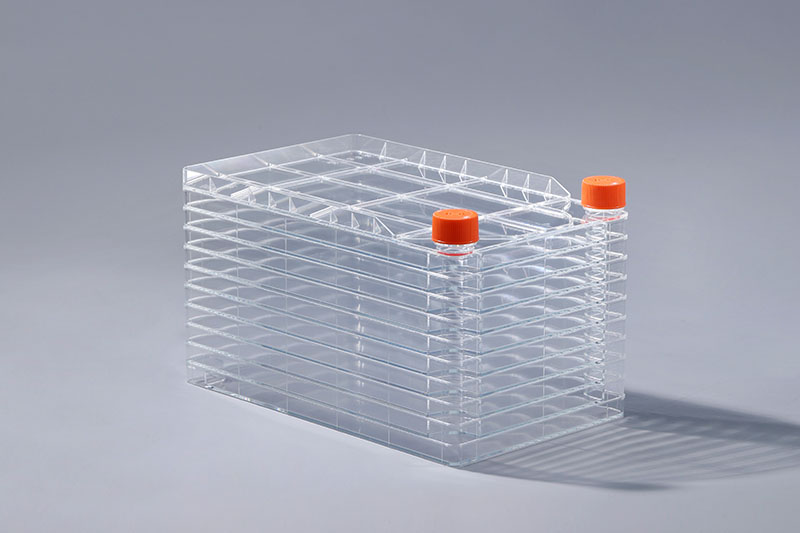သည် ဆဲလ်ယဉ်ကျေးမှု စားသုံးနိုင်သော အလွှာပေါင်းစုံဖွဲ့စည်းပုံဖြစ်ပြီး၊ အဓိကအားဖြင့် ဗိုက်ထရိုဆဲလ် ယဉ်ကျေးမှုအတွက် အဓိကအသုံးပြုသည်။ ဆဲလ်များ မွေးမြူရာတွင် သီးခြားပတ်ဝန်းကျင်တစ်ခု လိုအပ်ပြီး ဓာတ်ငွေ့ပတ်ဝန်းကျင်နှင့် pH တန်ဖိုးသည် အရေးကြီးဆုံး အခြေအနေများထဲမှ တစ်ခုဖြစ်သည်။ ဆဲလ်စက်ရုံမှ ရည်ညွှန်းသော ဓာတ်ငွေ့ပတ်ဝန်းကျင်သည် ဆဲလ်များကို မွေးမြူသည့်အခါ အဓိကအားဖြင့် ကာဗွန်ဒိုင်အောက်ဆိုဒ်ဖြစ်ပြီး၊ အောက်ဆီဂျင် အောက်ဆီဂျင်သည် ဆဲလ်များ၏ tricarboxylic acid လည်ပတ်မှုတွင် ပါဝင်ပြီး ဆဲလ်ကြီးထွားမှု၊ ကြီးထွားမှုနှင့် လိုအပ်သော အစိတ်အပိုင်းအမျိုးမျိုးကို ပေါင်းစပ်ရန်အတွက် စွမ်းအင်ထုတ်ပေးသည်။ အချို့သောဆဲလ်များသည် hypoxic အခြေအနေအောက်တွင် glycolysis မှတဆင့်စွမ်းအင်ကိုရရှိနိုင်သော်လည်းဆဲလ်အများစုသည် hypoxia အောက်တွင်မရှင်သန်နိုင်ပါ။ အောက်ဆီဂျင်တင်းအားကို ပုံမှန်အားဖြင့် လေထုအခြေအနေအောက် အနည်းငယ်တွင် ထိန်းသိမ်းထားပြီး အောက်ဆီဂျင်၏ တစ်စိတ်တစ်ပိုင်းဖိအားသည် လေထုအတွင်းရှိ အောက်ဆီဂျင်ပမာဏထက် ကျော်လွန်ပါက အချို့သောဆဲလ်များကို ထိခိုက်ပျက်စီးစေနိုင်ပါသည်။ အပွင့်ယဉ်ကျေးမှု (ပန်းကန် သို့မဟုတ် ယဉ်ကျေးမှုပုလင်းအဖုံးချောင်သည့်ယဉ်ကျေးမှု သို့မဟုတ် ပန်းကန်ပြားယဉ်ကျေးမှု) ကိုအသုံးပြုသည့်အခါ ဆဲလ်များသည် ယေဘူယျအားဖြင့် 95% လေထုနှင့် ကာဗွန်ဒိုင်အောက်ဆိုဒ် 5% ပေါင်းစပ်ထားသော ဓာတ်ငွေ့ပတ်ဝန်းကျင်တွင် ထားရှိကြသည်။ဆဲလ်စက်ရုံ
ကာဗွန်ဒိုင်အောက်ဆိုဒ်သည် ဇီဝဖြစ်စဉ်တစ်ခုသာမက၊ ဆဲလ်များသာမက ဆဲလ်ကြီးထွားမှုအတွက် မရှိမဖြစ်လိုအပ်သော အစိတ်အပိုင်းတစ်ခုဖြစ်ပြီး ယဉ်ကျေးမှုအလတ်စား၏ pH ကို ထိန်းသိမ်းခြင်းနှင့် ဆက်စပ်သည်။ ပိတ်ထားသောပတ်ဝန်းကျင်တွင် ကာဗွန်ဒိုင်အောက်ဆိုဒ်ပါဝင်မှုနည်းသောအခြေအနေတွင်၊ ဆဲလ်များသည် ကြီးထွားရန်လွယ်ကူသည်။ ယေဘုယျအားဖြင့်၎င်းသည် 1% ထက်မနည်းနိုင်လျှင်မဟုတ်ပါကဆဲလ်များပျက်စီးလိမ့်မည်။ ပွင့်လင်းယဉ်ကျေးမှုကို ကာဗွန်ဒိုင်အောက်ဆိုဒ် 5% ပါ၀င်သော ဓာတ်ငွေ့ပတ်ဝန်းကျင်တွင် ထားရှိပါက အကြံပြုလိုပါသည်။
ဆဲလ်အများစုသည် pH 7.2~7.4 တွင် ကြီးထွားရန် သင့်လျော်သည်၊ pH 6.8 ထက်နည်းသော သို့မဟုတ် pH 7.6 ထက်ပိုမိုနိမ့်ပါက ဆဲလ်များကို အန္တရာယ်ဖြစ်စေနိုင်ပြီး၊ ပျက်ယွင်းသို့မဟုတ်သေပင်။ မတူညီသောဆဲလ်များတွင် pH တန်ဖိုးအတွက် မတူညီသောလိုအပ်ချက်များရှိသည်။ ယေဘူယျအားဖြင့်၊ မူလယဉ်ကျေးမှုဆဲလ်များသည် အက်ဆစ်ခံနိုင်ရည်ထက် အယ်ကာလီ pH တန်ဖိုးကို ခံနိုင်ရည်နည်းပြီး အက်စစ်ဓာတ်ရှိသော ပတ်ဝန်းကျင်သည် အယ်ကာလိုင်းပတ်ဝန်းကျင်ထက် ဆဲလ်ကြီးထွားမှုအတွက် ပိုမိုအကျိုးရှိသည်။ ယဉ်ကျေးမှုပတ်ဝန်းကျင်၏ စဉ်ဆက်မပြတ် pH တန်ဖိုးကို ထိန်းသိမ်းရန်အတွက် ဖော့စဖိတ်ကဲ့သို့သော ကြားခံထဲသို့ ဖော့စဖိတ်ကို ကြားခံထည့်နည်းကို မကြာခဏ အသုံးပြုပါသည်။
သက်ရှိသိပ္ပံနယ်ပယ်၏ လျင်မြန်စွာ ဖွံ့ဖြိုးတိုးတက်လာသည်နှင့်အမျှ ဆဲလ်စက်ရုံများကို ပိုမိုအသုံးချလာကြသည်။ လယ်ကွင်းများ။ သို့သော် မည်သည့်နယ်ပယ်တွင် အသုံးပြုသည်ဖြစ်စေ ဆဲလ်ယဉ်ကျေးမှုအတွင်း ဓာတ်ငွေ့ပတ်ဝန်းကျင်နှင့် pH တန်ဖိုးများသည် ဆဲလ်ကြီးထွားမှုအတွက် အရေးကြီးသော အခြေအနေများထဲမှ တစ်ခုအဖြစ် ရှိနေဆဲဖြစ်သည်။
With the rapid development of the field of life science, cell factories are being applied to more fields. But no matter which field it is used in, the gas environment and pH value during cell culture are still one of the important conditions for cell growth.
The FAI climbed 5.9 percent year-on-year in the first 11 months of 2018, quickening from the 5.7-percent growth in Jan-Oct, the National Bureau of Statistics (NBS) said Friday in an online statement.
The key indicator of investment, dubbed a major growth driver, hit the bottom in August and has since started to rebound steadily.
In the face of emerging economic challenges home and abroad, China has stepped up efforts to stabilize investment, in particular rolling out measures to motivate private investors and channel funds into infrastructure.
Friday's data showed private investment, accounting for more than 60 percent of the total FAI, expanded by a brisk 8.7 percent.
NBS spokesperson Mao Shengyong said funds into weak economic links registered rapid increases as investment in environmental protection and agriculture jumped 42 percent and 12.5 percent respectively, much faster than the average.
In breakdown, investment in high-tech and equipment manufacturing remained vigorous with 16.1-percent and 11.6-percent increases respectively in the first 11 months. Infrastructure investment gained 3.7 percent, staying flat. Investment in property development rose 9.7 percent, also unchanged.
 English
English



















































